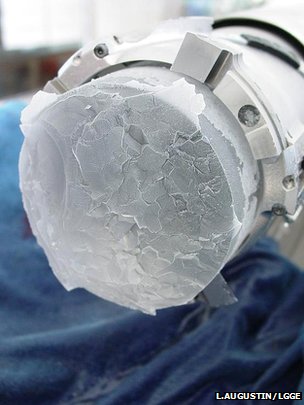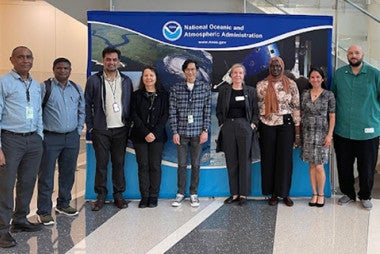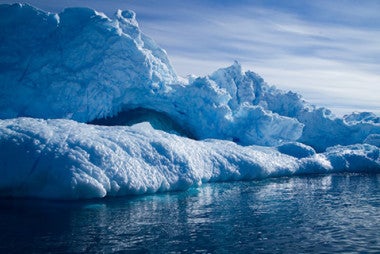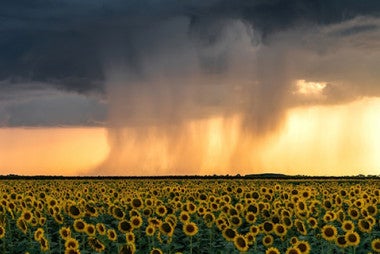Jeremy Shakun | How Carbon Dioxide Melted the World
Global data set shows that rising greenhouse-gas levels drove the end of the last ice age.
Jeremy Shakun, Ph.D., is the lead author of the new study, published April 4 in the Nature International Journal of Science, and a National Oceanic and Atmospheric Administration fellow at Harvard and Columbia universities.

Jeremy's postdoctoral research is supported by the NOAA Climate & Global Change Postdoctoral Fellowship Program administered by the University Corporation for Atmospheric Research (UCAR). The overarching purpose of the program is to help create and train the next generation of leading researchers needed for climate studies. The fellowship program has developed an outstanding reputation of attracting the best and the brightest PhDs in the sciences relevant to the NOAA Climate and Global Change Program.
Shakun’s study has helped to paint the fullest picture yet of how a handful of factors, particularly world-wide increases in atmospheric carbon dioxide, combined to end the last ice age approximately 20,000 to 10,000 years ago.
Though scientists have known for many years, based on Antarctic ice cores, that temperature and CO2 were linked over the Ice Ages, establishing a clear cause-and-effect relationship has remained difficult. In fact, when studied closely, the ice-core data indicate that CO2 levels rose after temperatures were already on the increase, a finding that has often been used by global warming skeptics to bolster claims that greenhouse gases do not contribute to climate change.
Many climate scientists have addressed the criticism and shown that the lag between temperature and CO2 increases means that greenhouse gases were an amplifier, rather than trigger, of past climate change, but Shakun and his colleagues saw a larger problem – while CO2 measurements taken from air bubbles in the ice cores reflect levels throughout the global atmosphere, temperatures recorded in the ice only reflect local Antarctic conditions.
To get a more accurate picture of the relationship between global temperature and CO2, they synthesized dozens of temperature records – 80 in all – collected from around the world from seafloor sediments, lake mud, and ice cores.

"Putting all of these records together into a reconstruction of global temperature shows a strong correlation with rising CO2 at the end of the ice age. Even more interesting, while CO2 trails Antarctic warming, it actually precedes global temperature change, which is what you would expect if CO2 is causing the warming," Shakun said.
I think this research points a strong finger at CO2 as the big driver of global warming during this time.”
Armed with that evidence, Shakun and colleagues were able to sketch out how a series of factors aligned that eventually led to a worldwide warming trend and the end of the ice age.
The first domino to fall was likely a gradual change in Earth’s orbit. That orbital change resulted in more sunlight hitting the northern hemisphere. As the ice sheets over North America and Europe melted, a huge amount of fresh water flooded into the North Atlantic and disruped the global conveyor belt of ocean circulation. This ocean conveyor normally drags heat northward across the equator, helping to explain why the Northern Hemisphere is today a couple degrees warmer than the south. But when it shut down as the ice age ended, the south no longer had its heat stolen away by the north and so began warming.
Warming the southern hemisphere, in turn, shifted the winds and melted back sea ice that had formed a cap, trapping carbon in the deep ocean.
As more and more CO2 entered the atmosphere, Shakun said, the global warming trend continued, “and pretty soon you’re headed out of an ice age.”
While the research strengthens the link between CO2 and the Ice Ages, Shakun believes it also reinforces the importance of addressing CO2-driven climate change in our own time.
“I don’t think this tells us anything fundamentally new about global warming,” Shakun said. “Most scientists are not in doubt about the human-enhanced greenhouse effect – there are nearly a dozen strong pieces of evidence that it is affecting global climate. This is just one more log on the fire that confirms it.”
Interviews & Articles of Interest
National Public Radio "Shake It Off: Earth's Wobble May Have Ended Ice Age"
U.S. News "Study aims to settle climate battle over temperatures, CO2 "
Scientific American "What Thawed the Last Ice Age?"
BBC News Science & Environment " CO2 drove end to last ice age"
Science AAAS "Greenhouse Gas is No Weakling"
Nature "How carbon dioxide melted the world"
From the Lab Bench "Old News for Carbon Dioxide, New Threats for Climate Change"









